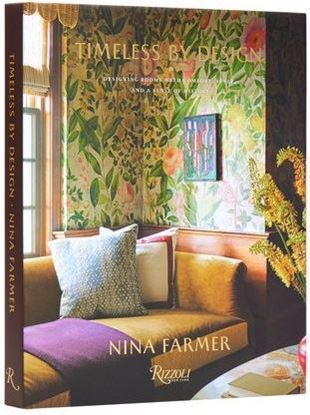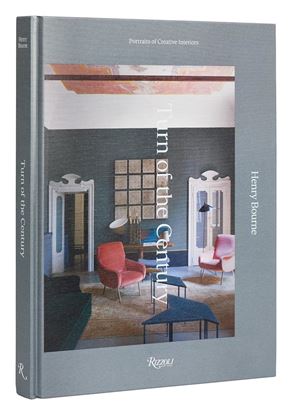

TIMELESS BY DESIGN
Designer Nina Farmer has made a name for herself with her classically beautiful interiors. From reimagining century-old homes to more modern dwellings, Farmer has a way of creating looks that celebrate the past and simultaneously live squarely—and stylishly—in the present. In these pages, Farmer introduces readers to the design solutions she has found for creating that special combination: a carefully curated mix of the classic and the contemporary that looks like it was collected over time rather than created all at once.
3,500
TIMELESS MODERN INTERIORS
The first book to feature the interior design of the stylish, award-winning firm RRP / Rees Roberts + Partners, led by Interior Design–hall of fame inductee Lucien Rees-Roberts.
As Pilar Viladas writes in her introduction, “Rees-Roberts does not have a signature style. Instead, the interiors designed by his New York firm … have style, period, and lots of it.”
Well-known for his subtle use of color, texture, and fabric, Rees-Roberts’s designs capture the essence of modern living. Descended from generations of painters, his love for art is an important source for his inspiration and indelibly marks the work. Functionally elegant designs are characterized by a deference to art as well as to light and the views provided by natural surroundings. Each designed home reflects the owner’s character as well as the needs of everyday life, incorporating custom furniture and unusual antiques. The book, bound in sumptuous cloth and wrapped in a jacket with French folds, reflects the firm’s ever-present attention to detail.
4,300
TODO BANKSY
Banksy es el artista vivo más famoso del mundo, pero nadie conoce su identidad. Durante más de veinte años, sus pinturas irónicamente políticas y de humor negro han aparecido misteriosamente en las paredes urbanas de todo el mundo generando titulares y controversia. Los críticos de arte lo desprecian, pero el público (y el mercado del arte) lo aman. Con este libro, generosamente ilustrado, la artista y crítica Carol Diehl es la primera autora en sondear las profundidades del misterio de Banksy. A través de la exploración de sus pinturas, instalaciones, escritos y la película "Exit Through the Gift Shop (Pase por la tienda de recuerdos antes de salir)", nominada a los Oscar a la mejor película documental, Diehl demuestra inequívocamente que Banksy es más que pintura en la pared.
1,700
TODOPODEROSOS: CON MI PELI NO TE METAS
Cine y humor de la mano del podcast cultural con la comunidad más sólida de España.
El primer libro de Todopoderosos.
Todos tenemos películas supuestamente malas que no podemos dejar de ver una y otra vez. Cintas denostadas por público y crítica que, por diversos motivos, se nos han quedado pegadas, se han ganado un lugar en nuestro corazón.
Armados de argumentos, referencias y sentido del humor, Juan Gómez- Jurado, Rodrigo Cortés, Javier Cansado y Arturo González-Campos defienden en este libro este tipo de películas. A través de joyas desconocidas, placeres culpables, obras nostálgicas y bodrios divertidísimos, nos invitan a reconectar con el cine más allá de puntuaciones y tendencias efímeras para vivirlo como lo que es: una experiencia intelectual pero, sobre todo, emocional.
900
TOP SECRET. CINE Y ESPIONAJE
La primera obra consagrada a la fructífera relación entre el espionaje y el cine, las series de televisión o incluso los dibujos animados, desde la película Protea, dirigida por Victorin Jasset en 1913, a los trabajos de Fritz Lang, Alfred Hitchcock, Kathryn Bigelow, Brian de Palma, John Huston o Laura Poitras.
Organizado por orden alfabético, este libro ofrece además entrevistas en exclusiva con realizadores como Olivier Assayas, Arnaud Desplechin y Éric Rochant, o con la actriz y chica Bond Léa Seydoux, así como textos perfectamente documentados sobre la historia que ha entrelazado al cine con el espionaje.
Se muestran los resortes de la geopolítica mundial a través de James Bond, Jason Bourne, Argo, Misión Imposible, Shiri… o de series como Homeland, The Spy o Le Bureau des légendes [Oficina de infiltrados].
1,850
TURN OF THE CENTURY
Henry Bourne’s photographs of the residences and workspaces of a who’s who of creative people open windows onto the groundbreaking design approaches and trends of the last three decades.
For nearly thirty years, Bourne has been photographing the residences and studios of, or those designed by, some of the world’s most important artists, architects, designers, and innovators. Culture and society are constantly evolving, and changes, both aesthetic and sociological, are reflected in our physical surroundings. Spaces and portraits in this volume range from the Upstate New York studio of artist Richard Prince, Vincent Van Duysen’s early apartment in Antwerp, and Marc Newson’s residences (his modern former bachelor pad as well as the more textured apartment he shares with Charlotte Stockdale today) to the joyfully chaotic London atelier of artist Paula Rego, the Villa Volpi by architect Tomaso Buzzi near Rome, the London studio of artists Tim Noble and Sue Webster—before and after its sleek renovation, designed by architect David Adjaye.
4,995














